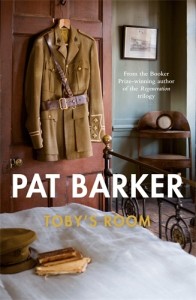 Published by Hamish Hamilton 30 August 2012
Published by Hamish Hamilton 30 August 2012
272 pp, hardback, £16.99
Reviewed by Zoë Fairbairns
It’s the summer of 1912, and, in the eponymous room, art student Elinor Brooke is having sex with Toby, her older brother. Later, Elinor makes an unexpected discovery about Toby’s origins.
Both episodes cast their shadows over the next few years; but a longer one is cast by the outbreak of war in 1914. Toby and Elinor have to decide their response, as do Elinor‘s friends at the Slade School of Fine Art: Kit Neville, who answers his country’s call to arms, and Paul Tarrant who volunteers as a medical orderly. Elinor herself keeps calm and carries on painting.
If some of these names and storylines sound familiar, it’s because we have met these characters before, in Pat Barker’s most recent novel Life Class (2007).
Toby’s Room is both sequel and prequel. Whether either was necessary is another question. The characters and their dilemmas (to fight or not to fight? If women aren’t allowed to vote, why should they be patriotic? What is the role of an artist in wartime?) are enough to sustain one novel, but perhaps not two. Toby’s Room lacks the conviction of Barker’s earlier First World War novels, a sense that the author really cares about what she is doing – or indeed that she is doing anything more than using up material that didn‘t make it into Life Class.
Granted there is some development of character and plot. (Spoiler alert: stop reading now if you don’t want to know what happens.) Paul moves on from dressing soldiers’ wounds to becoming a wounded soldier himself. His injuries are not as serious as those of the erstwhile ladies’ man Kit, who has most of his face shot away. Visiting him in hospital, Elinor finds a use for her drawing skills as a medical artist, working with surgeons to design new features for men like Kit.
So far, so absorbing. But there’s more. Or less, depending on how you look at it. There’s discussion of art, but too much of it relates to paintings which we can’t see because they’re fictional, and which are described only through the eyes of their creators, or their creators’ friends, teachers or lovers, none of whom can be expected to be entirely objective. It’s hard to have an attitude to biased views of fictional artworks.
Important stories – particularly the sexual ones – are only half-told. The brother-sister sexual encounter in Chapter One is not described in any detail – we first see Elinor spurning Toby’s approaches on a shared country walk, but when late at night she makes her way to his room in her nightie, it’s clear that her purpose is not to suggest a game of cards. We see that, ‘he reached out, closed his hand gently round her wrist and pulled her down towards him,’ but that’s it. If it wasn’t a chapter ending, you might expect a row of nudge-nudge dots. Afterwards the episode is referred to only obliquely, so we don’t know what to think. What’s it like to have sex with your brother? I don’t know, I haven’t got a brother, but if it’s an important part of a novel I’m reading, then I’d like to read about it. Even if the mechanics of the act are the same as with anyone, what do you actually say? Isn’t it, you know, embarrassing?
Similar vagueness surrounds the sexually-versatile Toby’s later liaison, this time with a man, when both are serving on the Western Front. Toby is by then an army officer; the other man is a young stable hand. Few contemporary readers of Pat Barker would have a problem with the idea of two men in a war zone finding love and sexual comfort with each other – we would probably applaud. But the only account Barker gives us is that of Kit Neville, who happens upon the couple, and later describes what he saw: ‘We’re talking about a man exploiting his inferiors. (Toby) Brooke was an officer. That lad couldn’t have said no even if he’d wanted to…It’s no use idealizing that kind of thing. It’s not Greek love, you know, it’s just another form of bullying. I hated it at school and I hate it now.’ When this is the only account we have – and Kit Neville, traumatized by injuries, doped with painkillers and steeped in prejudices of his own, may or may not be a reliable narrator – there‘s no basis for the reader to have an attitude to the revelation of Toby’s homosexuality, or the suicidal way he chooses to escape its legal and social penalties.
The book ends with Elinor clearing out Toby’s room and finding, on his mattress, a ‘small stain’. She is then seen ‘leaving Toby’s room for the last time.’ It’s probably a good idea.
